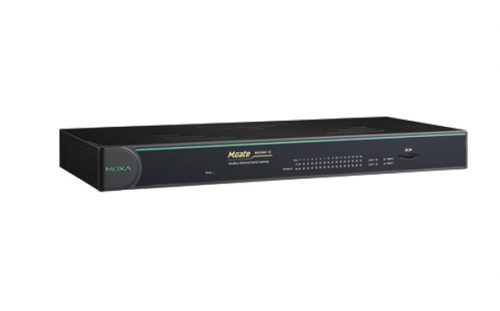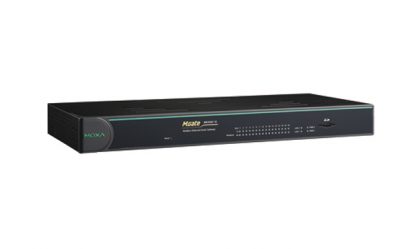MGate MB3660 Series
8 and 16-port redundant Modbus gateways
- Description Specs Details Overview Components Packages Resources Additional Modules Complementary products Architecture Tools Benefits Features Customer Ordering
- Thông số Specs Details Overview Components Packages Resources Additional Modules Complementary products Architecture Tools Benefits Features Customer Ordering
- Ordering Specs Details Overview Components Packages Resources Additional Modules Complementary products Architecture Tools Benefits Features Customer Ordering
- Tài liệu Specs Details Overview Components Packages Resources Additional Modules Complementary products Architecture Tools Benefits Features Customer Ordering
Features and Benefits
- Supports Auto-Device Routing for easy configuration
- Supports route by TCP port or IP address for flexible deployment
- Innovative Command Learning eliminates the need to key-in
- SCADA Modbus commands (acts as an agent gateway)
- High performance through active and parallel polling of serial devices
- Supports serial (Master) to serial (Slave) communications
- 2 Ethernet ports with the same IP or dual IP addresses
- SD card for configuration backup
- Access by up to 256 TCP master/client devices, or connect to 128 TCP slave/server devices
- Dual VDC or VAC power inputs with wide power input range
- 3-pin fault relay circuit for event alarms
- 2 kV isolation protection (for “-I” models)
Overview
The MGate MB3660 (MB3660-8 and MB3660-16) series gateways are redundant Modbus gateways that convert between the Modbus TCP and Modbus RTU/ASCII protocols. They can be accessed by up to 256 TCP master/client devices, or connect to 128 TCP slave/server devices. The MGate MB3660 series isolation model provides 2 kV isolation protection suitable for power substation applications. The MGate MB3660 gateways are designed to easily integrate Modbus TCP and RTU/ASCII networks. The MGate MB3660 series gateways offer features that make network integration easy, customizable, and compatible with almost any Modbus network. For large-scale Modbus deployments, MGate MB3660 gateways can effectively connect a large number of Modbus nodes to the same network. The MB3660 series can physically manage up to 248 serial slave nodes for 8-port models or 496 serial slave nodes for 16-port models (the Modbus standard only defines Modbus IDs from 1 to 247). Each RS-232/422/485 serial port can be configured individually for Modbus RTU or Modbus ASCII operation and for different baudrates, allowing both types of networks to be integrated with Modbus TCP through one Modbus gateway.
High Performance with Innovative Command Learning
The MGate MB3660 series gateways support two communication modes: transparent mode and agent mode. For transparent mode, the gateway converts Modbus commands from Modbus TCP to Modbus RTU/ASCII, and vice versa, or from serial (Master) to serial (Slave). However, since only one Modbus protocol request-response action can be executed at any given time, each Modbus device has to wait its turn, resulting in poorer performance. Agent mode is designed to overcome this performance weakness. By allowing users to manually key in Modbus commands, the gateway can send Modbus commands to multiple Modbus devices at the same time. Since the gateway actively and continuously retrieves data from Modbus devices simultaneously through the different serial ports, users will see a dramatic reduction in the amount of time a Modbus device needs to wait to be accessed. SCADA systems can retrieve Modbus device data directly from the gateway’s memory, instead of waiting for the gateway to pass commands to the serial ports, enhancing the Modbus gateway’s communication performance. Transparent mode helps users adopt existing SCADA programs, but with reduced communication performance, whereas agent mode is characterized by high performance, but requires users to go through the trouble of keying in Modbus commands. In order to provide better performance, without requiring users to key in a lot of Modbus commands, the MGate MB3660 series gateways are designed with an innovative Command Learning function, which can be activated with a single mouse click. Once activated, the gateway will learn and remember the Modbus commands it receives, and once a command has been learned, the gateway will act as though it were in agent mode, and actively send Modbus requests to the relevant Modbus devices. Since the data is saved in a different memory space that can be accessed by the SCADA system, the SCADA system can retrieve Modbus response data directly from the gateway’s memory, instead of waiting for the data to pass through the Modbus devices, dramatically increasing communication performance.
Auto-Device Routing for Easy Configuration (Patent Pending)
Moxa’s Auto-Device Routing function helps eliminate many of the problems and inconveniences encountered by engineers who need to configure large numbers of Modbus devices. A single mouse click is all that’s required to set up a slave ID routing table and configure Modbus gateways to automatically detect Modbus requests from a supervisory control and data acquisition (SCADA) system. By removing the need to manually create the slave ID routing table, the Auto-Device Routing function saves engineers significant time and cost.
| • Ethernet Interface | |
| Protocols | Modbus TCP Client/Server |
| Number of Ports | 2 (2 IP addresses) |
| Speed | 10/100 Mbps, Auto MDI/MDIX |
| Connector | RJ45 x 2 |
| • Serial Interface | |
| Protocols | Modbus RTU/ASCII Master/Slave |
| Number of Ports | MGate MB3660-8: 8 MGate MB3660I-8: 8 MGate MB3660-16:16 |
| Serial Standards | RS-232/422/485, software selectable |
| Connectors | DB9 male |
| RS-485 Data Direction Control | ADDC® (automatic data direction control) |
| Isolation Protection | 2 kV (for “-I” model) |
| • Serial Communication Parameters | |
| Data Bits | 7, 8 |
| Stop Bits | 1, 2 |
| Parity | None, Even, Odd, Space, Mark |
| Flow Control | RTS/CTS, DTR/DSR, RTS Toggle (RS-232 only) |
| Baudrate | 50 bps to 921.6 Kbps |
| • Serial Signals | |
| RS-232 | TxD, RxD, RTS, CTS, DTR, DSR, DCD, GND |
| RS-422 | Tx+, Tx-, Rx+, Rx-, GND |
| RS-485-4w | Tx+, Tx-, Rx+, Rx-, GND |
| RS-485-2w | Data+, Data-, GND |
| • Software | |
| Configuration Options | Web console, Serial console, Telnet console |
| Utility | Device Search Utility (DSU) for Windows 95, 98, ME, NT, 2000, Windows XP, Server 2003, Vista, Server 2008 (x86/x64), Windows Server 2008 R2, Windows 7/8/8.1 (x86/x64), Windows Server 2012 (x64), Windows 2012 R2 |
| Network Protocols | TCP/IP, UDP, HTTP, SMTP, NTP, DNS, DHCP Client, SNMPv1 (read only), ARP, Telnet, Radius |
| Multi-master and Multi-drop | Master mode: 128 TCP slaves/servers Slave mode: 256 TCP masters/clients |
| • Physical Characteristics | |
| Fault Relay Circuit | 3-pin circuit with current carrying capacity of 2 A @ 30 VDC |
| External Storage Drive | SD card for configuration backup |
| Housing | Metal, IP30 |
| Weight | MGate MB3660-8-2AC: 2,731 g (6.02 lb) MGate MB3660-8-2DC: 2,684 g (5.92 lb) MGate MB3660I-8-2AC: 2,753 g (6.07 lb) MGate MB3660-16-2AC: 2,830 g (6.24 lb) MGate MB3660-16-2DC: 2,780 g (6.13 lb) |
| Dimensions | Without ears: 440 x 45 x 198 mm (17.32 x 1.77 x 7.80 in) With ears: 480 x 45 x 198 mm (18.90 x 1.77 x 7.80 in) |
| • Environmental Limits | |
| Operating Temperature | 0 to 60°C (32 to 140°F) |
| Storage Temperature | -40 to 85°C (-40 to 185°F) |
| Ambient Relative Humidity | 5 to 95% (non-condensing) |
| Vibration | IEC 60068-2-6, IEC 60068-2-64 |
| Shock | IEC 60068-2-27 |
| Drop | IEC 60068-2-32 |
| • Power Requirements | |
| Input Voltage | For DC models: Dual 20 to 60 VDC (1.5 kV isolation) For AC models: Dual 100 to 240 VAC, 47 to 63 Hz |
| Input Current | MGate MB3660-8-2AC: 144 mA @ 110 VAC; 101 mA @ 220 VAC MGate MB3660-8-2DC: 312 mA @ 24 VDC; 156 mA @ 48 VDC MGate MB3660I-8-2AC: 244 mA @ 110 VAC; 159 mA @ 220 VAC MGate MB3660-16-2AC: 178 mA @ 110 VAC; 120 mA @ 220 VAC MGate MB3660-16-2DC: |
| Power Connector | Terminal block (for DC models) |
| • Standards and Certifications | |
| Safety | UL 60950-1, EN 60950-1 (LVD) |
| EMC | EN 55032/24 |
| EMI | CISPR 32, FCC Part 15B Class A |
| EMS | IEC 61000-4-2 ESD: Contact: 6 kV; Air: 8 kV IEC 61000-4-3 RS: 80 MHz to 1 GHz: 10 V/m IEC 61000-4-4 EFT: Power: 1 kV; Signal: 1 kV IEC 61000-4-5 Surge: Power: 2 kV; Signal: 1 kV IEC 61000-4-6 CS: 150 kHz to 80 MHz: 10V/m IEC 61000-4-8 PFMF |
| • MTBF (mean time between failures) | |
| Time | MGate MB3660-8-2AC: 716,647 hrs MGate MB3660-8-2DC: 706,783 hrs MGate MB3660I-8-2AC: 224,851 hrs MGate MB3660-16-2AC: 487,416 hrs MGate MB3660-16-2DC: 482,835 hrs |
| Standard | Telcordia SR332 |
Available Models
| Model No. | Description | |
|---|---|---|
| MGate MB3660-8-2AC | Modbus gateway with dual LANs, dual AC power inputs, 8 RS-232/422/485 ports, 0 to 60°C operating temperature | |
| MGate MB3660-8-2DC | Modbus gateway with dual LANs, dual DC power inputs, 8 RS-232/422/485 ports, 0 to 60°C operating temperature | |
| MGate MB3660I-8-2AC | Modbus gateway with dual LANs, dual AC power inputs, 8 RS-232/422/485 ports, 0 to 60°C operating temperature, 2 kV isolation | |
| MGate MB3660-16-2AC | Modbus gateway with dual LANs, dual AC power inputs, 16 RS-232/422/485 ports, 0 to 60°C operating temperature | |
| MGate MB3660-16-2DC | Modbus gateway with dual LANs, dual DC power inputs, 16 RS-232/422/485 ports, 0 to 60°C operating temperature |
Optional Accessories
 Connectors
Connectors
| Model No. | Description | |
|---|---|---|
| Mini DB9F-to-TB | DB9 Female to Terminal Block connector |
New Technology Automates Arduous Routing Setup in Modbus Gateways
When a lot Modbus devices need to be monitored and controlled, engineers usually have to spend a lot of time planning the topology of these devices and segmenting them into different subgroups. Moreover, they are also weighed down by the mundane task of keying in hundreds of Modbus slave IDs to set up each Modbus gateway’s Modbus slave ID routing table. Thus, engineers are constantly on the lookout for solutions that address this pain point when setting up multiple Modbus devices. This white paper takes a closer look at different routing technologies and their pros and cons, as well as a new technology that helps save time and costs when configuring and managing a large number of Modbus devices.
How to Architect Your Systems to Get the Most Out of Your Modbus Devices
The migration of all industrial applications to Ethernet is unquestioned. But, before network engineers can inch closer toward all-systems-go, they need to overcome several challenges. The most pressing one is to ensure that there is no breakdown in communication between serial devices and SCADA hosts. It is no secret that plenty of solutions are available on the market. The immediate question is which solution fits your network’s requirements the best.
In this white paper, we will look at four challenges that arise when linking up Modbus-supported devices to SCADA systems. We will also provide solutions for different scenarios to address your concerns.



